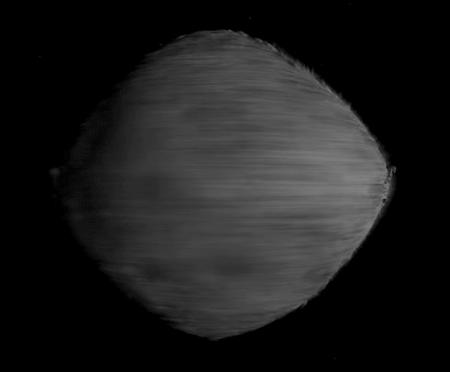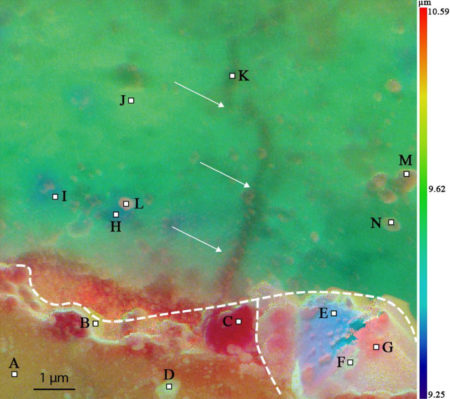SCIENTIFIC ACHIEVEMENT
Using a nanoscale infrared probe at the Advanced Light Source (ALS), researchers found that the minerals in a meteorite—an artifact representing the solar system’s past—were altered by water on very fine spatial scales.
SIGNIFICANCE AND IMPACT
The work sheds light on conditions in the early solar system and lays groundwork for analyzing asteroid samples to be returned to Earth by NASA in 2023.

A nanoscale view of the early solar system
Meteorites—in particular, a type called chondrites—are a good source of primordial solar system material. These rocks preserve the histories of their parent bodies in tiny round inclusions (chondrules) and the fine-grained matrix materials that surround them. Moreover, carbonaceous chondrites often contain water and prebiotic organic molecules, which they likely delivered to Earth through impacts during accretion.
To learn more about the geochemistry of the early solar system, a team led by researchers from Stony Brook University used infrared (IR) spectroscopy and microscopy to characterize the mineral composition of a carbonaceous chondrite (ALH 83100) at nanometer spatial scales. The work nicely demonstrates the type of capabilities that will be available for analyzing the pristine asteroid samples being returned to Earth next year by NASA’s OSIRIS-REx mission.
Return from Bennu

The OSIRIS-REx spacecraft was launched in 2016 and will return samples from the near-Earth asteroid, Bennu, in 2023. Bennu is a primitive body that’s been linked to carbonaceous chondrites like ALH 83100. However, unlike many meteorites, samples from Bennu will not have been altered by terrestrial weathering or microbes.
The ability to analyze these pristine samples using nano-IR spectroscopy would be invaluable. Remote-sensing of Bennu’s surface using IR light from orbit results in a resolution of typically several meters at best, with the signal averaged out between huge boulders and fine dust. With nano-IR, scientists can pick out individual mineral and organic components, potentially answering questions such as whether organics occur in association with certain minerals.
At the chondrule’s edge
In this work, the researchers used single-wavelength IR imaging and broadband synchrotron IR nanospectroscopy (SINS) at ALS Beamline 2.4 to locate and probe a region of ALH 83100 where interesting geochemical processes might have taken place: the boundary between a chondrule and the surrounding matrix. The ability to correlate synchrotron-based broadband spectroscopy with single-wavelength microscopy using tunable lasers at the beamline is highly advantageous and not readily available elsewhere.
A multispectral nano-IR map was generated by assigning colors (red, green, and blue) to key vibrational modes. The resulting false-color image provides a clear picture of the compositional variability in this portion of the sample. Nano-IR spectra were collected at specific locations based on this spectral variability.

History written in the matrix
The results indicate that the chondrule contains forsterite, a magnesium-rich form of olivine. The matrix consists of phyllosilicates, which are products of aqueous alteration (as minerals dissolve and precipitate, for example). Interestingly, the mix of iron and magnesium in the matrix varied within very small distances from the chondrule, indicating a highly variable, heterogeneous process. More iron further away from the chondrule indicated that there was more pervasive alteration earlier in the sample’s history.
The researchers are currently working on a project for the NASA Laboratory Analysis of Return Samples (LARS) Program to enable correlated analyses using multiple techniques, including nano-IR at the ALS. The researchers believe it will be an important tool in decades to come, not only for analyzing samples returned from space but also in linking remote-sensing data with sample-scale measurements.
Contact: Timothy Glotch
Researchers: J.M. Young, T.D. Glotch, and L.B. Breitenfeld (Stony Brook University); M. Yesiltas (Kirklareli University, Turkey); V.E. Hamilton (Southwest Research Institute); and H.A. Bechtel, S.N. Gilbert Corder, and Z. Yao (ALS).
Funding: National Aeronautics and Space Administration, and Scientific and Technological Research Council of Turkey. Operation of the ALS is supported by U.S. Department of Energy, Office of Science, Basic Energy Sciences program.
Publication: J.M. Young, T.D. Glotch, M. Yesiltas, V.E. Hamilton, L.B. Breitenfeld, H.A. Bechtel, S.N. Gilbert Corder, and Z. Yao, “Nano-FTIR Investigation of the CM Chondrite Allan Hills 83100,” JGR Planets 127, e2021JE007166 (2022), doi:10.1029/2021JE007166.
ALS SCIENCE HIGHLIGHT #466